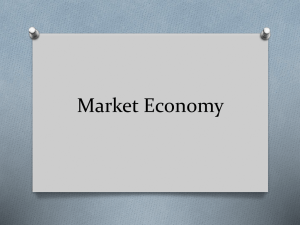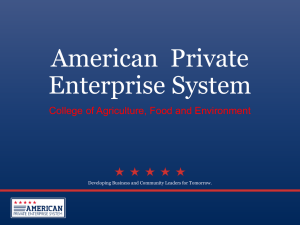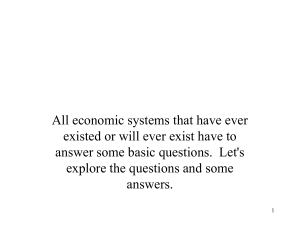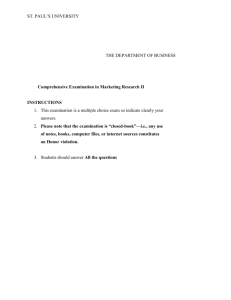The Market Economy Name: The Economy
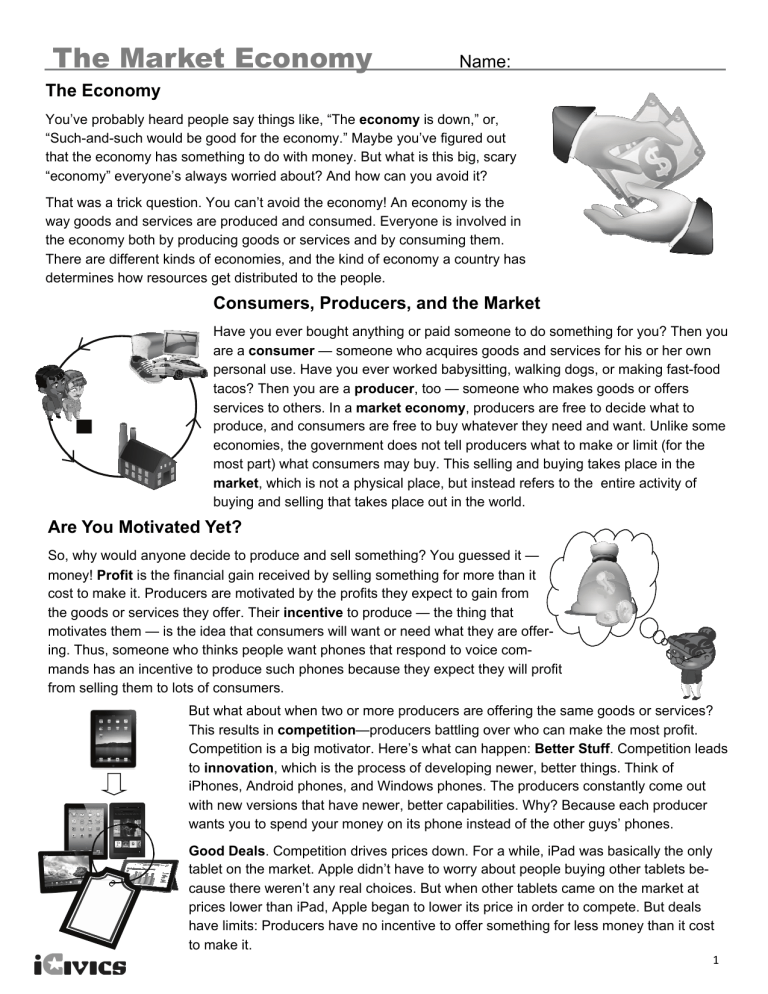
The Market Economy
Name:
The Economy
You’ve probably heard people say things like, “The economy is down,” or,
“Such-and-such would be good for the economy.” Maybe you’ve figured out that the economy has something to do with money. But what is this big, scary
“economy” everyone’s always worried about? And how can you avoid it?
That was a trick question. You can’t avoid the economy! An economy is the way goods and services are produced and consumed. Everyone is involved in the economy both by producing goods or services and by consuming them.
There are different kinds of economies, and the kind of economy a country has determines how resources get distributed to the people.
Consumers, Producers, and the Market
Have you ever bought anything or paid someone to do something for you? Then you are a consumer — someone who acquires goods and services for his or her own personal use. Have you ever worked babysitting, walking dogs, or making fast-food tacos? Then you are a producer , too — someone who makes goods or offers services to others. In a market economy , producers are free to decide what to produce, and consumers are free to buy whatever they need and want. Unlike some economies, the government does not tell producers what to make or limit (for the most part) what consumers may buy. This selling and buying takes place in the market , which is not a physical place, but instead refers to the entire activity of buying and selling that takes place out in the world.
Are You Motivated Yet?
So, why would anyone decide to produce and sell something? You guessed it — money! Profit is the financial gain received by selling something for more than it cost to make it. Producers are motivated by the profits they expect to gain from the goods or services they offer. Their incentive to produce — the thing that motivates them — is the idea that consumers will want or need what they are offering. Thus, someone who thinks people want phones that respond to voice commands has an incentive to produce such phones because they expect they will profit from selling them to lots of consumers.
But what about when two or more producers are offering the same goods or services?
This results in competition —producers battling over who can make the most profit.
Competition is a big motivator. Here’s what can happen: Better Stuff . Competition leads to innovation , which is the process of developing newer, better things. Think of iPhones, Android phones, and Windows phones. The producers constantly come out with new versions that have newer, better capabilities. Why? Because each producer wants you to spend your money on its phone instead of the other guys’ phones.
Good Deals . Competition drives prices down. For a while, iPad was basically the only tablet on the market. Apple didn’t have to worry about people buying other tablets because there weren’t any real choices. But when other tablets came on the market at prices lower than iPad, Apple began to lower its price in order to compete. But deals have limits: Producers have no incentive to offer something for less money than it cost to make it.
1
The Market Economy
Name:
It’s All About Supply and Demand
When a market economy is doing well, there is lots of buying and selling. During a
“bad economy,” buying and selling slows down. The cycle of ups and downs depends mainly on two things: supply , the amount of something that is available, and demand , the number of consumers who want it. Supply and demand are called market forces because they act to make the market function well or poorly.
Supply and Demand Out of Balance
To keep everyone producing, making profits, and buying things, supply and demand must be balanced. Here’s what can happen if there is high demand but low supply:
Imagine there is a big freeze in Florida and orange trees are damaged. Fewer oranges are available. If there is still a big demand for oranges, the price will go up. Fewer oranges also means there aren’t as many oranges to process. Some people who pick oranges and get them ready to sell might lose their jobs.
On the other hand, too much supply with low demand can also hurt. Imagine a coal producer is very busy over the summer and mines tons and tons of coal. Winter comes, but it doesn’t get very cold. People don’t use their furnaces as much as usual, so they don’t need as much coal. All of that coal sits around unused—and they certainly don’t need to mine any more coal. The price of coal will drop, and some people involved in producing coal could lose their jobs because there is already too much.
Scarcity and Opportunity Cost
Imagine your class is deciding whether to sell candy or glow sticks for a fundraiser. Which will earn more money? People like sweets, so you decide to sell candy. In making that decision, your class gives up whatever benefit it might have gotten by choosing to sell glow sticks instead. The benefit you give up by choosing to do one thing instead of another is called opportunity cost . When you are in the process of making your choice, you try to determine which choice has more benefits and take a risk that you might be wrong.
You can’t always predict the opportunity cost—but sometimes you can!
The need to choose one thing over another exists because of scarcity — the limited amount of resources available. Why not sell candy and glow sticks?
Probably because it would cost too much up front to buy both. If there were unlimited resources, everyone could have everything they want and need, and there would be no need to make choices. But because of scarcity, producers and consumers must make choices that are sometimes very difficult.
The Command Economy
The opposite of the market economy is the command economy, where the government decides what will be produced, how much will be produced, and how much goods and services will cost. Thus, the relationship between supply and demand does not determine what gets produced and consumed. Instead, the government makes those decisions. The government owns the equipment for production, so the government is everyone’s employer. There is no private property in a pure command economy, so people can’t sell things to make a profit.
People are consumers, but they buy what the government produces.
2
The Market Economy
Name:
What’s the Opportunity Cost?
Directions: For each situation, write the opportunity cost – what the person gave up by making the decision. (Hint: Don’t worry about the math. Describe the cost in WORDS.)
1) Clink or swim?
Sam’s boss called to offer her an extra shift tonight. Sam wanted the money, but she’s got a big swim meet tomorrow and needed sleep. She told her boss to offer the shift to someone else.
2) An Interest -ing
Choice
Jason can put his money in a savings account and earn about 12 cents in interest this month, or he can loan it to Matt, who says he’ll return the money plus
$20 at the end of the month. He loans it to
Matt.
3) Risky Business
Lacey designs dresses.
She can keep designing casual dresses that bring $65 but are easy to sell, or she could design formal gowns that sell for $500 but must be high fashion. She takes a risk on formal gowns.
4) An air-y hard decision
If Zephyr, Inc. spends
$2 million buying out its main competitor, it can earn $3 million in new sales. It if spends $2 million designing a new airship, it might make
$4 million if it can sell
10 ships. It buys the competitor.
The opportunity cost is: The opportunity cost is:
The opportunity cost is:
The opportunity cost was:
3
